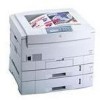Xerox 2135DT Service Guide - Page 65
Poor fusing, toner offsetting
 |
UPC - 042215474696
View all Xerox 2135DT manuals
Add to My Manuals
Save this manual to your list of manuals |
Page 65 highlights
Poor fusing, toner offsetting 1. Is a supported paper type being used? Try printing on a different brand of paper. 2. Is the fuser unit properly installed and making good electrical contact with the print engine? Inspect its connector. 3. Inspect the fuser. Are its rollers contaminated or damaged? 4. Ensure the media type is correctly set. 5. Does AC voltage appear between Pins 1 and 2 of CN 4-1 and CN 4-2 of the fuser connector. These pins connect to Pins A and B on the fuser's underside when the fuser is installed; remove the fuser to check. If not, replace the power supply. 6. Is the resistance of the fuser's upper roller thermistor (at room temperature) between 190 to 980 Ω? If not replace the fuser. 7. Is the resistance of the fuser's lower roller thermistor (at room temperature) between 190 to 980 Ω? If not replace the fuser. 8. Is the fuser temperature correct during printing? Run the maintenance mode fuser test "Test printing" on page 71 and check the temperature displayed on the controller panel. 9. Replace the engine controller board. Transfer the old engine controller board's EEPROM (lower-right corner of board) to the new engine controller board. Offsetting and fuser temperature. Offsetting occurs on specialty paper if the fuser's temperature does not match the paper loaded in the multi-sheet bypass feeder. For cold-offsetting, characterized by toner flaking off the completed print, you want to raise the fuser's temperature. For hot-offsetting, characterized by toner pulled off print as it is fused, you want to lower the fuser's temperature. The chart below lists the specialty paper types and relative fuser temperatures used. To correct offsetting, select the next paper type above or below the current paper type you are using. Removing and reloading paper in the multi-sheet bypass feeder, prompts you for the paper type at the control panel. Hottest fuser temperature used Thick Cardstock Glossy Thin Cardstock Heavy Paper Plain Paper Light Paper Coolest fuser temperature used 52 Phaser 2135 Color Printer















